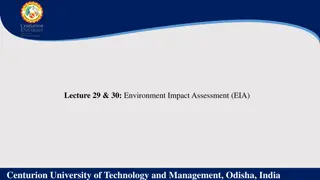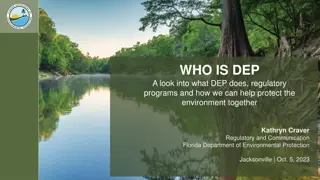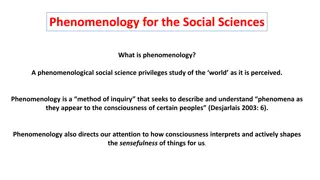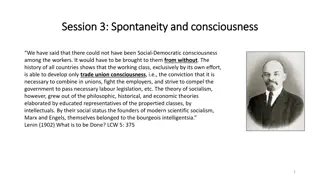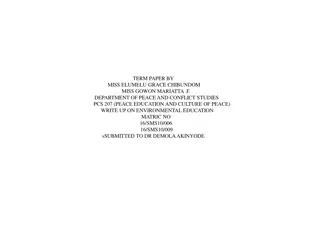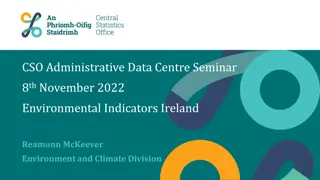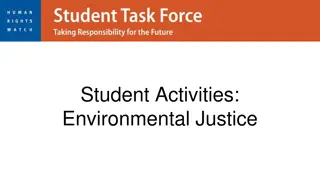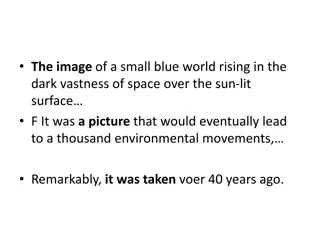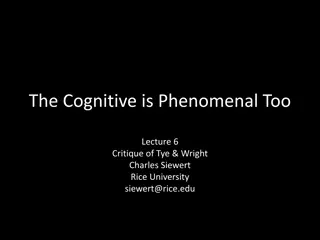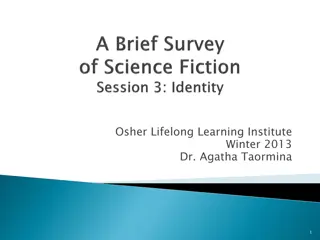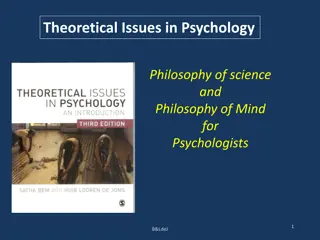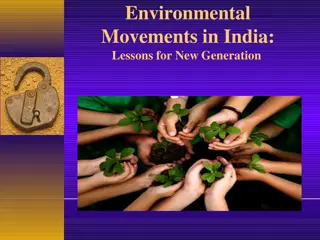Evolution of Environmental Consciousness: A Historical Perspective
The evolution of environmental consciousness is traced through key milestones like the emergence of ecological science, formation of environmental organizations, and the rise of New Social Movements. From the pioneering works of Ernst Haeckel to the foundation of Friends of the Earth and Greenpeace, the journey towards sustainable coexistence with nature is explored. The shift in societal values, reactions against industrial growth, and advocacy for sustainable development are highlighted as integral aspects of this evolving consciousness.
Download Presentation

Please find below an Image/Link to download the presentation.
The content on the website is provided AS IS for your information and personal use only. It may not be sold, licensed, or shared on other websites without obtaining consent from the author.If you encounter any issues during the download, it is possible that the publisher has removed the file from their server.
You are allowed to download the files provided on this website for personal or commercial use, subject to the condition that they are used lawfully. All files are the property of their respective owners.
The content on the website is provided AS IS for your information and personal use only. It may not be sold, licensed, or shared on other websites without obtaining consent from the author.
E N D
Presentation Transcript
Origins of Green Thought B t n buffalolar ld r ld kten, yaban atlar ehlile tirildikten, ormanlar n en gizli k eleri binlerce insan n a r kokusuyla dolduktan, sevimli tepelerin g r nt s konu an tellerle kirletildikten sonra Bir bakacaks n z ki G kteki kartallar yok olmu . H zl ko an taya ve ava elveda demi siniz. Bu ne demektir biliyor musunuz? Bu ya am n sonu ve s rf daha fazla hayatta kalman n ba lang c d r. Duwarmish K z lderilileri reisi
The first pictures taken from space created the cognition that the world is a whole transcending national/regional borders (the blue planet).
The first person who used the term ecology is Ernst Haeckel (1834-1919): the science of the relationship between the organisms and their environments. Haeckel criticizes how humans see the nature, an entity out of the realm of the humans that could be fully exploited as they wish. This is a Descartian understanding of the nature (anthropocentrism). Haeckel argues that humans are a part of the nature. Environmentalism and ecology are different. The former uses the term sustainable development and argues for the continuation of things as they are but at the same time more environmentally friendly. The latter, however, thoroughly questions our way of living, our industrial complex and our patterns of consumption.
As environmental consciousness develops, the number of the organizations dealing with it increases and more and more people started to work in an active manner in them. These organizations would be one of the important cores of the New Social Movements. Friends of the Earth was established in 1969 and Greenpeace in 1971. The former had 114 thousand members in 1970, and 566 thousand in 1990. The latter had 6 thousand members in 1975, 80 thousand in 1980, 450 thousand in 1985 and 2 million in 1990.
The Reasons for New Social Movements A reaction against the problems created by industrial growth and technological development. Reorganization of the relations among economy, state and the society. Change in social values and the rise of post-materialist values. Rebellion of the educated middle-classes whose upward mobility was limited because of the economic conditions. Reaction against the contradictions of modern societies and alienation.
The Greens in Germany At the beginning of the formative years, citizen groups and anti-culture movements unite in anti-nuclear movement. In mid-1970s, they achieved some local successes. In 1977 elections they got a significant portion of the votes in Baden-W rttemberg and Schleswig-Holstein. In 1979 European Parliament elections they got 3.2% of the votes with their emphasis on ecology, society, direct democracy and anti-violence agenda. With 1984 elections, they got 42 MPs with %8.3 of the votes.
Basic points Critique of human centeredness (anthropocentrism). Critique of economic growth that does not raise the quality of life. Human intervention to the nature has reached a point which threatens human existence on earth. Our social, economic and technological structures and value systems need to be reformulated. We need to rethink which of our needs are truly vital. We need to mind the lives of other species on earth. For a green future, we need to struggle in an active manner.
Assumptions Global scale is important. The world is at risk as a whole. Ecological catastrophes do not heed national borders: acid rain, Chernobyl, global warming. Global society must be rethought it its relationship with the local communities. We are decimating other species. This must stop.
Themes: State and power Kyoto was signed in December 1997 and put into effect on 16 February 2005. It was the action plan of the UN against climate change. The countries that signed the original plan but not ratified are: The US, Afghanistan, Andorra, and South Sudan. Canada pulled its signature back in 2011 December. Annex I countries pledged to cut back the greenhouse gases (carbondioxyde, metane, nitrusoksit, sulphure heksaflorid) ve hydroflourocarbonve perflourocarbon gases.
Top-ten emitters What follows is a ranking of the world's top ten emitters of GHGs for 2005 (MNP, 2007).The first figure is the country's or region's emissions as a percentage of the global total. The second figure is the country's/region's per- capita emissions, in units of tons of GHG per-capita: China1 17%, 5.8 United States3 16%, 24.1 European Union-273 11%, 10.6 Indonesia2 6%, 12.9 India 5%, 2.1 Russia3 5%, 14.9 Brazil 4%, 10.0 Japan3 3%, 10.6 Canada3 2%, 23.2 Mexico 2%, 6.4
Questions: Can China pollute to the extent of the USA? What are the differences between the US and Europe?
Themes: International Organizations 1992 World Summit (Rio) is the first global UN summit about environmental issues. This summit accepts the term sustainable development as the main understanding about the environment. This concept was first accepted in 1987 at the World Commission on Environment and Development (Brundtland Commission). The policies about the ozone depletion were successful. Yet, the policies about the global warming has been not so successful yet.
Themes: Peace and Security Depletion of water resources Diminishing of agricultural resources to feed the global population: genetically engineered food. Global environmental catastrophiescreated by global warming threatens mass migrations.
Themes: Inequality and justice Majority of global resources are being used by the minority of people on earth. However, all of the peoples pay for the environmental costs. Acid raids caused by American industries affect Amazons.



